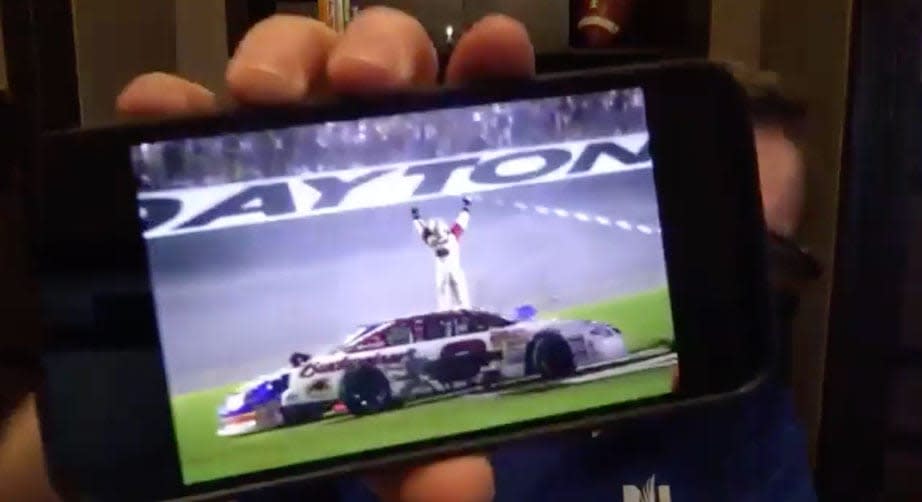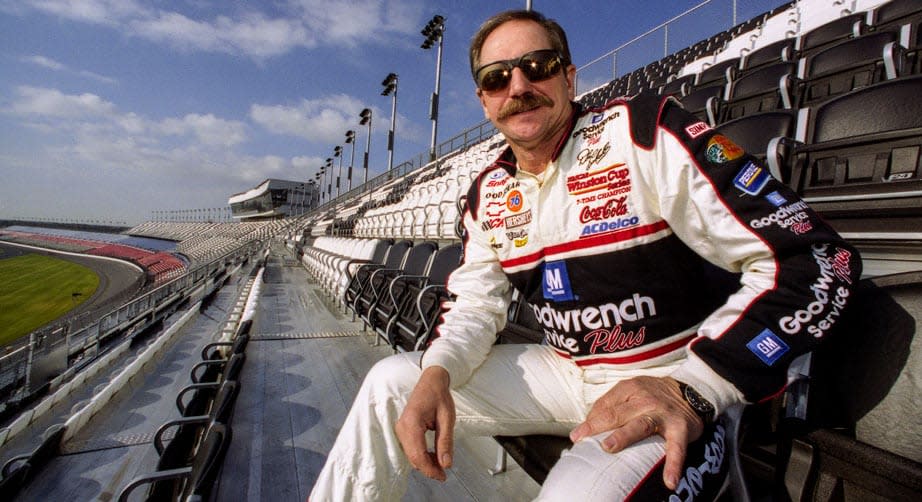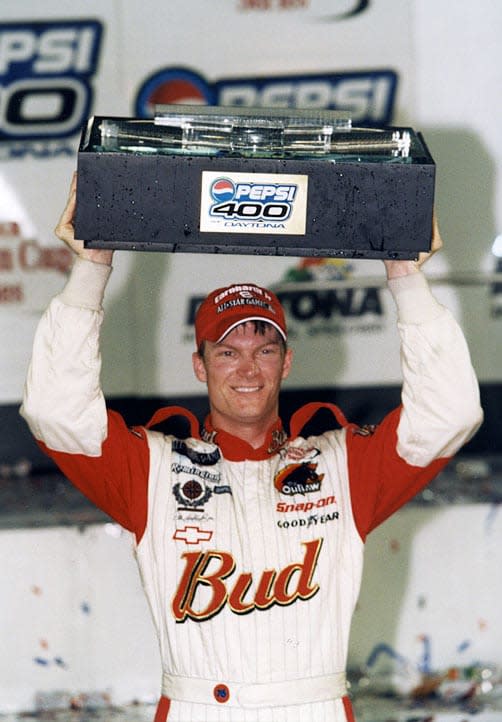A winning embrace
For Dale Earnhardt Jr., the most enduring memory from his signature win comes not from inside the car but from outside of it. “Let me show you,” he says. He reaches across his desk, grabs his phone, pulls up a photo from the 2001 Pepsi 400 and holds it up to the Zoom camera. “This is the moment that I wish I could go back and do again.”
The picture shows Junior from behind, standing on his car, arms raised in triumph. In front of him, the enormous Daytona International Speedway grandstand yawns high and in both directions. Every seat is empty because every fan is standing. One of the most amazing wins in NASCAR history is only a few minutes old, and nobody — not Earnhardt Jr., not his team, not the fans — could believe what they just saw. Had the most beloved driver in the sport really just won in the first race at the track after his father died there?
Even now, as Dale Jr. talks about how winning the Pepsi 400 20 years ago today changed the trajectory of his life, he seems to scarcely believe it happened. He calls it storybook, says it was meant to be, suggests it was ordained by the gods, as if he was along for the ride in the car he was driving. He is less the hero of his own story and more a wide-eyed and grateful beneficiary.
That’s why he loves the moment captured in that photo. The emotions spilling out of him to the grandstands and echoing back to him from the delirious fans mixed sorrow and joy in a delicious cocktail of what it is to be utterly and completely human. We only know great pain because we also know great love. They hold each other in tension, and we are most alive when they intersect. “We’re having this amazing feeling. I can’t physically embrace all those people that are up there in the grandstands,” says Junior. “But that’s as close as I can get.”

More than most if not all athletes, Earnhardt Jr. relishes being both a participant in and witness to the history of his sport. He knew, immediately, the enormity of the moment for himself and for the sport. He won 26 Cup races, including two Daytona 500s. This was bigger than all of them. This was bigger than one race, bigger than one win, bigger than a mad dash to victory. This was grabbing 100,000 people all at once and hugging them and crying and laughing and mourning all at the same time.
“If you have a friend, and they just lost someone they love, and you go see them, the first thing you do is you put your arms around him,” he says. “In that moment right there, that’s what we’re all doing.”
• • •

If you have a friend, and they just lost someone they love, and you go see them, the first thing you do is you put your arms around him.

Before the win so powerful Dale Earnhardt Jr. hates to imagine his life without it, before the win he rewatches over and over to remind himself to be grateful for the uncountable blessings life has given him, before he stood on the roof of his car and opened his arms as if to embrace every person in the grandstands at Daytona International Speedway, he first had to make sure he didn’t hate the place.
In the summer of 2001, still mourning the death of his father that February, Earnhardt Jr., who was elected to the NASCAR Hall of Fame last summer and serves as an analyst for NBC Sports, drove from Charlotte to Florida with plans to spend the off-week before the summer Daytona race the way he always spent it — drinking beer and raising hell with his friends. But this time he had a stop to make first: the speedway, his first visit there since his dad died in a wreck in Turn 3 on the last lap of the Daytona 500.
Whatever emotions were going to flood out of him from being there again, he wanted that to happen away from the TV cameras and reporters and mechanics and drivers who would be present when the track opened for practice.
“I wanted to continue to embrace it and continue to try to do good things there and add to Dad’s legacy and be proud of his legacy there,” he says. The track, he says, “wasn’t what killed him,” but he needed to make sure he wasn’t bitter at the track for it anyway. He needed to know he could be there and not fall apart. Or, if he was going to fall apart, he wanted to do it before the rest of the NASCAR world arrived and scrutinized his every move.
The entry gate was open, so he pulled his Suburban onto the track, turned right, and started driving. The track rolled in front of him, as wide and barren as the grief he was trying to outrun.
He planned to drive through Turns 1 and 2, down the backstretch, and pull off into the infield in Turn 3. He almost didn’t make it there. A security guard stopped him and started yelling at him … until, that is, the security guard recognized this most famous of trespassers. “Oh, it’s you,” the guard said. “What are you doing here?”
Dale Jr. explained himself. “Don’t worry, we’re not going to tear anything up,” he said.
The man understood. “Take your time,” he told him.
Junior continued perhaps the slowest lap he ever turned at this track that gave him so much heartache and joy and where in a week he would secure arguably the most emotionally powerful victory in NASCAR history. He parked at Turn 3 and faced the wall that his dad’s famous black No. 3 Chevrolet had hit head on. “We spent about 15 or 20 minutes standing there just looking,” he says.
The anxiety he had about being there washed away.
He didn’t hate the track.
He climbed back into the Suburban, drove away, and raised hell for a week.

• • •
When he returned, the car was fast in practice and fast in the race. His normally red car was white that day because Major League Baseball was a sponsor alongside Budweiser. He seemed unbeatable until a late caution shuffled the field. He hit the pits and took four tires; other drivers took two. He restarted the race sixth with six laps to go.
Because his No. 8 Dale Earnhardt Inc. Chevy had been out front all night, he wasn’t sure how it would handle when he tried to pass people. To hear Junior tell it, he won despite his shortcomings — shortcomings that limited his career. In pressure situations, he says, he too often took a negative view. He worried about the pain of losing instead of seeing the opportunity for glory.
He watched a Chase Elliott interview before the season finale last year. Elliott gushed about the opportunity to win a championship. That was never how Earnhardt viewed a tense situation. He obsessed about the possibility of losing. “If there was looming disappointment, that always was what I’d focus on,” he says.
For most of the 2001 Pepsi 400, he didn’t get caught up in winning or losing. He was just racing, he says, “needle-focused on the hood in front of me.” But as the race restarted with six to go, he worried the race had been taken from him. He didn’t know this at the time, but his crew chief gave an interview in which he said the best car wasn’t going to win the race.
In the car, Junior’s attitude was only marginally better. “I’m like, hyperventilating, like panicking, like, I gotta get up front, I gotta get up front, I gotta get up front,” he says.
That’s not normally a technique that takes a driver to Victory Lane. But on this night, it worked. The car was as fast trying to get the lead as it was protecting it. He moved from sixth to third in the first lap of the restart and took the lead on the second.
On the last lap, he had an open track in front of him and a teammate, Michael Waltrip, behind him. He had a momentary sense of dread that something crazy was going to happen to cost him the race. But when he took Turn 4 and nothing was amiss, he knew the win was his.
He crossed the finish line, dropped his window netting and raised his left hand out the window, pumping it exuberantly. He pulled into the grass, slid his car across it, stopped and jumped out. He climbed onto his roof and raised his arms. Someone took a picture, that picture was posted to social media 20 years later, and Dale Jr. saw it and downloaded it to his phone.
And as he holds it up to the Zoom camera, he smiles widely.
• • •
Enter Parallax Text
While he knew this was big in the moment, as he stood on his car, he did not know, at least not yet, how important this win would become in the rest of his life.
Now 20 years later, he sees it as a crucial pivot point and a cathartic step as he grieved his father. This was not closure, but it was proof that he could smile again.
There were questions before that night about whether Dale Earnhardt Inc. could go on without its namesake at the helm. That win ended those questions. Though Dale Jr.’s relationship with DEI deteriorated until he left before the 2008 season, the stress of keeping that company moving forward weighed heavily on him in the wake of his father’s death.

When Dad died, I was lost — personally, mentally, focus, everything. I was just kind of wandering about.

And the win did more than just save DEI. It helped Dale Jr. put his life back together. “When Dad died, I was lost — personally, mentally, focus, everything.
I was just kind of wandering about,” he says. “I had no vision, no future. And there were times in those moments that I just wanted to die. I was like, I don’t want to be here. I want to go wherever Dad’s at.”

He thrives on affirmation. He yearns to know that he belongs, that he’s good enough, that he’s not just a man with a famous name. This win drowned him in affirmation, and the confidence he gained from it is an indelible part of the man he is today.
If he starts to feel “a little frustrated about a situation or a result or a predicament,” he watches the race to remind himself of where he’s been and what he’s done, who he was then and who he became. By the time he sees himself take the checkered flag, hears NBC play-by-play man Allen Bestwick say, “Dale Earnhardt Jr., using lessons learned from his father to go from sixth to first, and score the victory in the Pepsi 400,” his gratitude returns.
“Man,” he tells himself. “You’ve had such a great life.”

